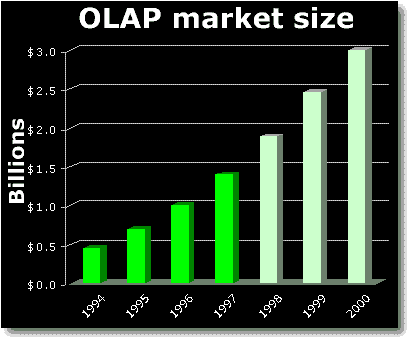| |

The arrival of SQL-Server 7.0 provides an awesome opportunity
to bring decision support to a vast new market that previously couldn't afford
OLAP solutions.
Richard Creeth, Creeth, Richman & Assoc.
|
|
|
|
| |
Rocky Mountain High OLAP
|
| When a group of Colorado community colleges wanted an affordable
OLAP solution, it turned to Microsoft. And Microsoft turned to integrator
Len Silverston.
"Why can't reports summarize data the way we want it?"
Solutions integrator Joe Misiaszek has tried to answer that question for
years. His programmers pounded out reports as fast as they could, but
it was never fast enough.
|
"Understand the customer's needs and get the users
to buy into the design. That's key to success for any data warehouse."
Len Silverston,
Quest Data Solutions, LLC
|
 |
Misiaszek is manager of application software and IT at Community College Computer
Services (CCCS), an organization that maintains computers for 13 Colorado community
colleges, as well as the state board that governs them. These systems contain
enrollment and financial records for 2,500 students and 3,500 staff members.
The reports that emerge from the files were state-of-the-art 10 years ago, when
the system received its last major upgrade.
Last year Misiaszek's boss, Don Williamson, vice president of IT at CCCS, encouraged
him to investigate system upgrades. The more I looked at available decision-support
solutions, the bleaker the picture became, says Misiaszek. I couldn't cost-justify
anything I saw. Then he heard about the new OLAP engine that Microsoft Corp.
was bundling with SQL Server 7.0.
Microsoft offered the features Misiaszek needed at an affordable price,
but he had never implemented a data warehouse. Microsoft referred him to Len
Silverston, president of Quest Data Solutions LLC in Greenwood Village,
CO, a $9-million solutions-integration company specializing in databases and
data warehousing.
In February, CCCS hired Quest to jump-start and coordinate the project. Silverston's
first task: Understand the customer's needs and get the users to buy into
the design, he says. That's key to success for any data warehouse.
Subsequently a committee of powerful decision makers was formed, representing
every major constituency in the CCCS organization. Under Silverston's guidance,
the committee crafted a design that everyone could live with. (As with most
data-warehousing projects, Quest's design added new reporting capabilities that
augmented, but did not replace, the existing database.)
But the pilot test clinched the deal. OLAP presentations are very visual, and
if a picture is worth a thousand words, it also can be worth many thousands
of dollars to Silverston.
We brought the committee members into our lab and gave them the URL to
the data warehouse, says Silverston. I stood back and watched unaided
users generate year-to-date reports every bit as good as the ones programmers
create by hand. 'When can I get this on my desk?' was the only question they
asked.
Misiaszek and his three teammates were largely responsible for the production
phase. Len kept us focused on the plan and timetable, says Misiaszek,
but we did most of the actual development.
A prototype was completed in April 1998, and by late August the production
system was up and running in four schools and the state board. Misiaszek expected
to have all 13 schools online by the end of September.
What he's truly excited about, however is implementing this solution for less
than one- of the price that most other vendors quoted. The sum total: 14 Digital
Equipment Corp. AlphaServer 2100 quadprocessor servers, 14 copies of SQL Server
7.0, and Microsoft's OLAP server-all for less than $225,000.
What's Misiaszek going to do with the time he gains from having users crank
out their own reports? The state board is already asking how soon I can
add a data warehouse to the student information system.
|



